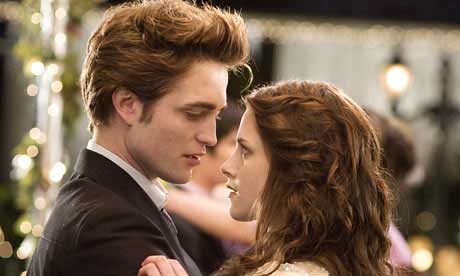Our current preoccupation with zombies and vampires is easy to explain. They're two sides of the same coin, addressing our fascination with sex, death and food. They're both undead, they both feed on us, they both pass on some kind of plague and they can both be killed with specialist techniques – a stake through the heart or a disembraining. But they seem to have become polarised. Vampires are the undead of choice for girls, and zombies for boys. Vampires are cool, aloof, beautiful, brooding creatures of the night. Typical moody teenage boys, basically. Zombies are dumb, brutal, ugly and mindlessly violent. Which makes them also like typical teenage boys, I suppose.
要解釋我們現(xiàn)在對僵尸與吸血鬼的癡迷,似乎并不困難。它們?nèi)缤幻队矌诺恼疵妫云湫愿小⑺劳雠c特殊的主食迎合著我們的好奇心。它們長生不老,以人類為食,傳播某種瘟疫,并且需要特殊手段才能被殺死----釘入心臟的木樁或者挖出腦子。但它們似乎被極端化了。永生的吸血鬼是女孩們的選擇,而僵尸則更符合男孩們的胃口。吸血鬼冷酷、孤傲、俊美、晝伏夜出,正如喜怒無常的十幾歲男孩。僵尸則沉默寡言,兇殘,丑陋,頭腦簡單,脾氣狂躁,也同樣是十幾歲男孩的典型特征。

Zombie stories are life lessons for boys who don't mind thinking about bodies, but can't cope with emotions. Vampire stories are in many ways sex for the squeamish. We don't need Raj Persaud to tell us that plunging canines into soft warm necks, or driving stakes between heaving bosoms, are very basic sexual metaphors.
如果說僵尸電影為那些對死尸毫不畏懼卻為感情問題困擾的男孩上了一堂人生課,吸血鬼故事則在某些意義上為那些神經(jīng)脆弱的人提供了性的暗示。拉吉·佩爾紹德(Raj Persaud)無需向我們解釋將尖牙咬入溫暖的頸窩或者在洶涌的胸部之間插入筆直的木樁是最基本的性隱喻。
There are now even whole sections of bookshops given over to the new genre of "supernatural romance". Maybe it was ever thus. Dr Polidori, who wrote the very first vampire novel, The Vampyr, based his central character very much on his chief patient, Lord Byron, and the Byronic "mad, bad and dangerous to know" archetype has been at the centre of both romantic and blood-sucking fiction ever since. Dracula, Heathcliffe, Rochester, Darcy and not to mention chief vampire Bill in Channel 4's new series True Blood are all cut from the same cloth. Meyer even claims that she based her first Twilight book on Pride and Prejudice, although Robert Pattinson, who plays the lead in the movie version, looks like James Dean in Rebel Without A Cause. Either way, vampire = sexy rebel.
現(xiàn)在有些書店甚至分出了一個新的流派——“超自然浪漫文學”。也許這種傳統(tǒng)由來已久,首部吸血鬼題材文學作品《吸血鬼》的作者波里道利,就將他的主要病人——拜倫——作為主角的原型。也是從那時起,拜倫式的“瘋狂、邪惡和危險”便成了這類充滿浪漫和血腥的文學的主題。吸血鬼伯爵、希思克利夫、羅切斯特、達西更別提Channel 4新劇《真愛如血》中的吸血鬼比爾了,他們實際都同根同源。梅爾甚至聲稱《暮光之城》第一部的靈感來源于《傲慢與偏見》,但電影版的主演羅伯特·帕丁森中長相卻酷似《無因的反抗》中的詹姆斯·狄恩。總之,吸血鬼就等于性感的反抗者。
No zombie is ever going to be a pinup on some young girl's wall. Just as Pattinson and all the Darcy-alikes will never find space on any teenage boy's bedroom walls – every inch will be plastered with revolting posters of zombies. There are no levels of Freudian undertone to zombies. Like boys, they're not subtle. There's nothing sexual about them, and nothing sexy either.
沒有女孩會把僵尸的圖片張貼在墻上,同樣也沒有男孩會把羅伯特·帕丁森,和其他“達西”們的海報張貼在臥室的墻上——那里的每一寸都應該貼滿了叛逆的僵尸海報。僵尸形象中并沒有隱含深層次的弗洛伊德理論,與男孩們相似,他們毫無精細可言,沒有性暗示,也一點都不性感。
相關(guān)閱讀:
Twilight《暮光之城》精講之一
僵尸電腦 zombie computer
《僵尸肖恩》Shaun of the Dead
逃避外星人僵尸 妮可片場遇車禍
(來源:天星教育網(wǎng),英語點津編輯)